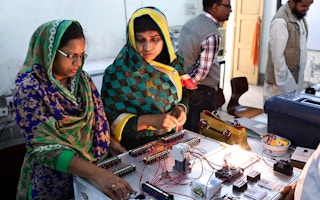A knitting factory in Bangladesh brings together the past, present, and future. On one floor, workers knit by hand. On another, people and machines do the work together. And on a third floor, there are only robots.
This building might seem like an anachronism, given the accepted wisdom that robots will replace humans in textiles and many other industries. But it is actually a savvy response to how the Fourth Industrial Revolution will likely play out in Asia.
As is the case elsewhere, technological advances are rapidly transforming industries and economies, by blurring the boundaries between the physical, digital, and biological worlds.
And yet much of Asia isn’t ready for robots, for reasons that go beyond fears of mass unemployment. In 2014, China had just 11 robots per 10,000 employees in non-automotive industries, and just 213 per 10,000 employees on automotive assembly lines. That is hundreds fewer than in Japan, the United States, or Germany.
Although China is closing the gap by increasing its spending on robots, poorer countries face significant barriers to adopting new technologies. Moreover, the region’s lower wages give firms an incentive to retain human workers.
At the factory in Bangladesh, human workers can step in if power outages or equipment failures knock the machines offline. At the same time, having a fully automated section allows production to continue if workers go on strike.
Conventional wisdom decrees that this dual-track approach isn’t sustainable, and that low- to middle-skilled workers will eventually make way for robots. A landmark 2013 study by Carl Frey and Michael Osborne of Oxford University suggests that, in the coming decades, 47% of total US employment will be at risk of automation.
Similarly, the International Labor Organization (ILO) has warned that 56% of total employment in Cambodia, Indonesia, the Philippines, Thailand, and Vietnam is “at high risk of displacement due to technology over the next decade or two.”
But these grim predictions ignore the fact that most jobs comprise a bundle of tasks, some of which cannot be automated. According to a 2016 OECD study that breaks down occupations by task, only 9% of jobs on average across 21 OECD countries are really at risk.
The same logic applies to Asia. In Vietnam, for example, the share of jobs at risk falls from the ILO’s predicted 70% to just 15% when the country’s large informal economy is taken into account. Street sweepers in developing countries are arguably less threatened by automation than their counterparts in developed countries, because their jobs are less mechanized and lower paid.
Still, robots are gaining a foothold in the region, particularly in economies such as China and South Korea. In 2015, robot sales in Asia increased by 19% – the fourth record-breaking year in a row. When less-developed Asian countries eventually join the technology bandwagon, layoffs will inevitably ensue.
To soften the blow, governments urgently need to pursue labor-market reforms and overhaul their education systems, starting with technical and vocational education and training (TVET). Although TVET is becoming increasingly popular in Asia’s developing economies, its quality is often poor.
Governments should ensure that TVET courses focus on more relevant skills, while remaining flexible so that students can study without sacrificing income.
“
At the end of the day, Asia’s developing countries need policies that support workers, rather than jobs.
One option is to expand the availability of modular short courses, which take less time, train for specific tasks rather than entire jobs, and are more manageable for entrants who need, first and foremost, to earn money.
In Myanmar, for example, the government has launched a pilot program to target the country’s “missing million” students who drop out of school each year. The program offers short courses on welding and other skills needed to repair rural machinery.
Competency-based assessment systems could also be particularly useful, given Asia’s large informal workforce. Programs offering skilled workers a chance to earn certifications based on their work experience would allow for, say, uncertified electricians to find formal employment in robotics.
The private sector can also help produce more graduates with job-ready skills. Asian countries should take a cue from India’s National Skill Development Corporation, which works with private training firms to match skills curricula with industry needs. So far, India’s program has helped train more than 63,000 people.
Furthermore, governments should offer subsidies or tax incentives to companies that invest in the skills that humans master better than machines, such as communication and negotiation. They will also have to adopt more flexible labor regulations, because firms won’t hire skilled workers who cost too much.
At the end of the day, Asia’s developing countries need policies that support workers, rather than jobs. All parties can benefit from flexible contracts and lifelong learning and retraining opportunities.
Retraining is particularly important, because automation will create entirely new industries and occupations. The McKinsey Global Institute estimates that automation could boost global productivity growth by 0.8-1.4% annually, generating large savings and performance gains for businesses.
Improving access to training and certification would help countries capitalize on these advances and ensure more equitable growth, by giving workers the skills needed to handle the new jobs.
That outcome would be good for workers and for Asian economies. It would mean that businesses like the factory in Bangladesh could operate solely with robots, while its former workers would be gainfully employed elsewhere, most likely in jobs that don’t even exist yet.
Stephen Groff is vice president (operations), Asian Development Bank. This article is republished from ADB.











